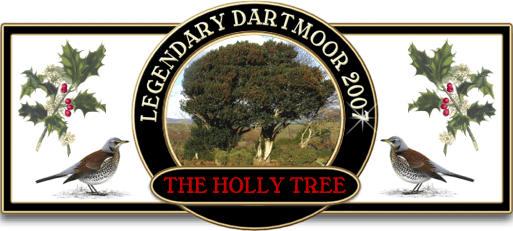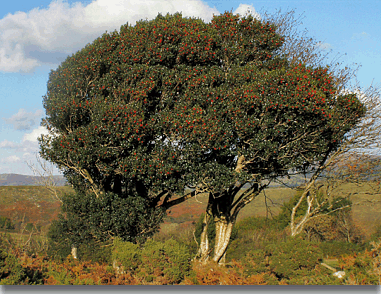
Today of you think of holly the chances are that Christmas will come to mind, but it hasn’t always been like that as at one time holly meant more than decorations. If you take Dartmoor as a whole, the holly bush is generally found on the lower fringes of the moor, they are however a few growing on the higher slopes.
For centuries the holly has been an important resource for moor dwellers, clearly its prickly leaves made it ideal for a stock-proof barrier, although it is a very slow grower so hawthorn tended to be the popular choice. Surprisingly the holly bush was also used as a winter fodder source because once above about 8ft the higher leaves have less need for protection against browsers and tend to have fewer prickles on them. The general practice was to clamber up the trees and then lop of the uppermost branches which would then be stored in the tallets for winter.
In medieval times there are examples where monasteries leased out stands of holly known as Hollins. Muir, 2005, p. cites an example at Fountains Abbey where Richard Atkinson took up such an arrangement in 1536. A lot closer to home is the woodland that once belonged to Buckfast Abbey called Holne Chase which is near the village of Holne. The actual place-name of Holne derives from Holla which can be found in the Domesday Book of 1086 which according to Gover et al, 1992, pp.301-2, means, “Place abounding in holly“. Could the same practice as occurred at Fountains Abbey been happening at Buckfast Abbey and their lands at Holne?
Today, most of the hollins have disappeared but many of the hedgerows on the moorland fringes contain large holly trees, like the one in the photograph below which stands on Holne Moor.

A Moorland Holly Tree
The wood of the holly tree is white, hard, fine grained and durable which meant it was used in lintels which stood over fireplaces as it was hard and fire resistant. There is a pub on the Blackdown Hills called the Holman Clavel which literally translates to ‘a holly beamed fireplace’. Holly wood was also used in various types of turning as in addition to its properties the wood took a stain well, often giving it the appearance of ebony. In this light such things as chess pieces were made from it as well as cabinet makers inlay. On the farm the wood was often used for tool handles, plough handles and cart pegs. Due to the woods ability to be finely smoothed the weaving industry often used it for the spinning rods as the threads wouldn’t snag.
Another popular use for holly wood brings us into the realms of superstition and tradition for many ploughmen and carters used whips and goads made from holly. The reasoning behind this was the belief that holly had the ability to exact control over any horse, no matter how wayward it might be. Another more dubious use of the holly tree was to produce ‘birdlime’. This was made from holly bark and nut oil and was smeared on branches in order to trap birds.
The holly tree can also predict the weather as people in Moretonhampstead always used to say that, “if the holly berries are plentiful then a severe winter is ahead“. It was also thought that holly had a protective nature and one old adage was that if you sheltered under such a tree during a thunderstorm you would never get struck by lightening. In a similar light that is why you can often see holly trees planted beside cottages and houses. Old Wives tales you may say but recent research has actually proven that the small prickles on the holly leaves act as tiny lightening conductors thus affording protection for the tree and anything nearby.
It was also considered very unlucky to cut down an entire holly tree, especially one that had self-seeded. Conversely it was always thought to be lucky to have a holly tree self-seed itself in the garden, and such a tree would bring prosperity to the owner. There was also a belief that it was very bad luck to cut down hedgerow hollies, the main thinking behind this was that witches used to fly along the tops of hedges and the prickly holly prevent such activities. So if the hollies were removed this turned the hedge into a veritable and unimpeded motorway for the hags on their broomsticks.
Any holly cut from a churchyard tree is supposed to be extra lucky as the holy sprig originated from a sacred place. In parts of the northern moor a sprig of holly pinned in the shippen or cow byre was said to insure the thriftiness of the animals. It was always considered terribly unlucky to bring holly into the house before Christmas Eve and even more so to leave it in the home after Candlemas Eve (1st February). Another northern Dartmoor version states that the holly must be removed on the 28th of December and any berries left were to be fed to the birds.
It is thought that the word holly is a corruption of the word ‘holy’ which comes from the belief that the red berries represent the blood spilt by Christ whilst he was on the cross and the prickles are a reminder of the crown of thorns which he wore. In Devon the variegated type of holly is often known as ‘spicketty holly’ or holy because the white spots on the leaves are said to have been drops of spilt milk from when Mary was feeding Jesus. Indeed around the south western fringes of the moor the Holly Tree was sometimes known as ‘Aunt Mary’s tree’. A one time vicar and well known Devonshire vicar, the Reverend R. S. Hawker wrote the following poem about Aunt Mary’s Tree:
Now of all the trees by the king’s highway,
Which do I love the best?
O! the one that is green upon Christmas Day,
The bush with the bleeding breast.
Now the holly with her drops of blood for me:
For that is our dear Aunt Mary’s tree.
Its leaves are sweet with our Saviour’s Name,
‘Tis a plant that loves the poor:
Summer and winter it shines the same,
Besides the cottage door.
O! the holly with her drops of blood for me:
For that is our kind Aunt Mary’s tree.

‘Tis a bush that the birds will never leave:
They sing in it all day long;
But sweetest of all upon Christmas Eve,
Is to hear the robin’s song.
‘Tis the merriest sound upon earth and sea:
For it comes from our own Aunt Mary’s tree.
So of all that grow by the king’s highway,
I love that tree the best:
‘Tis a bower for the birds upon Christmas Day,
The bush of the bleeding breast.
O! the holly with her drops of blood for me:
For that is our sweet Aunt Mary’s tree.
Going back to the times of the druids it was supposed that the holly tree was sacred to their beliefs. Because the holly is an evergreen and therefore always ‘living’ through the winter months it was taken to be a symbol of eternal life and therefore sacred. In the mythology of the time it was believed that the Holly King ruled over the earth from the summer solstice to the winter solstice. Then he lost a mighty battle with the Oak King who ruled from the winter solstice until the next summer solstice.
The tree held such magical powers that they made their ritual wands from its wood. Wistman’s Wood on Dartmoor has tradition that at one time it was a sacred grove of the ancient priests. To the best of my knowledge there is a lone single holly tree growing amongst the old gnarled dwarf oaks. In wintertime it is laden with the reddest of berries and about 12 years ago I cut a single sprig from it. Today that self same sprig sits on my desk with all its leaves and red berries intact. I have not treated it with anything or artificially dried it in any way and apart from a few wrinkles it appears as fresh as the day it was cut?

The ‘Sacred’ Wistman’s Wood Holly Sprig.
Medicinally, a tea made from the holly leaves is said to relieve the symptoms of rheumatism. One ‘kill or cure’ remedy for chilblains was to ‘thrash’ them with sprigs of holly which I am sure relieved the symptoms no end?
The other important role that the holly tree plays is that of a winter larder for many of the moorland birds. Indeed without the birds the spread of self-seeding trees would be impossible. For me there is nothing more wintery than to see a flock of fieldfares feasting on the plump red berries, this is a sure sign that a cold snap is due if not already arrived.

Gover, J. E. B., Mawer, A. & Stenton, F. M. 1992 The Place Names of Devon, English Place-Name Society, Nottingham
Muir, R. 2005 Ancient Trees, Living Landscapes, Tempus Publishing, Stroud.
 Legendary Dartmoor The many aspects past and present of Dartmoor
Legendary Dartmoor The many aspects past and present of Dartmoor

I have a question how deep can holly tree roots go I have 3holly trees growing in a cluster that’s how the birds left them in the yard my uncle always told me if the birds pooped them out then leave them their and don’t cut um down or replant them
These are full grown holly trees I top them every four years one trunk in the cluster is smaller and leaning toward the road that sometime I will have to cut it down but when it tries growing back I’m going to let it so the new trunk will be straight.
So does the holly tree roots grow how white pine tree roots grow more at the top if the soil or deeper.